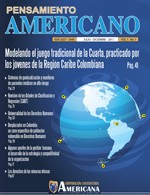Geolocation and Monitoring Systems for high-risk of high-risk medical patients
Keywords:
Georeferencing of patients, patient monitoring, GPSAbstract
The ability to georeference patients in emergency situations (eg in case of a heart attack) would give emergency
services valuable minutes that could mean the difference between life and death. Miniaturization and portability of
sensors and GPS transmitters facilitate this task. The operating system must generate an emergency alarm through
the device worn by the patient either by his wishes to operate a panic button or automatically by detecting abnormal
changes in vital signs. The paper addresses both the state of the art geolocation systems such as patient monitoring
systems, automated vital signs to determine the degree of viability.
Downloads
References
T.A. HERRING, “The Global Positioning System”, Scientific American, 1996, pag 32-38.
A. POZO-RUZ, et al. “Sistema de Posicionamiento Global (GPS): Descripción, Análisis de errores, Aplicaciones y Futuro”, Instituto de Automática Industrial, pag 5-6.
J. P. BLACK et al. “Pervasive Computing in Health Care: Smart Spaces and Enterprise Information Systems”, IBM
T.J. Watson Research Center, Hawthorne, NY.
WEI-HSUN Chen, MGuider: Mobile Guiding and Tracking System in Public Transit System for Individuals with Cognitive Impairments, Department of Electronic Engineering
Chung Yuan Christian University, Taiwan.
GTX Corp and Aetrex Worldwide, Inc. Enter Platform Test Agreement to Bring GPS Shoes to Senior Market -
Patented GPS Shoe Offers Caretakers Simple Solution to Locate “Wandering” Seniors Using 2-Way GPS Technology– 2009.
YAO-JEN Chang y Hung Huan Liu, “Mobile Social Networks as Quality of Life Technology for People with Severe Mental Illness”, IEEE Wireless Comunnication.
E. JOVANOV et al., “Patient Monitoring Using Personal Area Networks of Wireless Inteligent Sensors”, Electrical and Computer Engineering Department, University of Alabama”.
D. MALAM, T. Fulford-Jones, M Welsh y S. Moulton, “CodeBlue: An Ad-hoc Sensor Network Infraestructure for Emergency Medical Care”, Division of Engineering and Applied Science, Harvard University.
N. HASMI, et al., “A Sensor-based, Web Service-enabled, Emergency Medical Response System”, USENIX Association, EESR ’05: Workshop on End-to-End, Sense-and-Respond Systems, Applications, and services.
Downloads
Published
Issue
Section
License
Copyright (c) 2011 Pensamiento Americano

This work is licensed under a Creative Commons Attribution-NonCommercial-NoDerivatives 4.0 International License.
The author or authors of an article accepted for publication in the Journal Pensamiento Americano will transfer all of the patrimonial rights to the American University Corporation free of charge, within which are included: the right to edit, publish, reproduce and distribute both print media as digital, in addition to include in article in international indexes and / or databases, likewise, the Editorial Seal is authorized to use the images, tables and / or any graphic material presented in the article for the design of covers or posters from the same magazine. By assuming the patrimonial rights of the article, it may not be partially or totally reproduced in any printed or digital media without its express permission.
AUTHORITY ASPECTS
For the Pensamiento Americano Journal, all the authors of an article have made substantial contributions to the research and the manuscript, and they share the responsibility when the article presents errors, fraud in some way or violations of copyright.
After submitting an article, the journal does not accept the addition, deletion or change in the order of the authors, in addition we reserve the right to release the article when it has been submitted to the journal and under no circumstances will American Thought accept the article. withdrawal of an article during any phase of the editorial process






